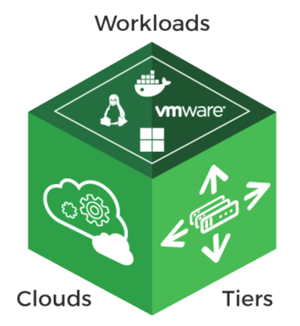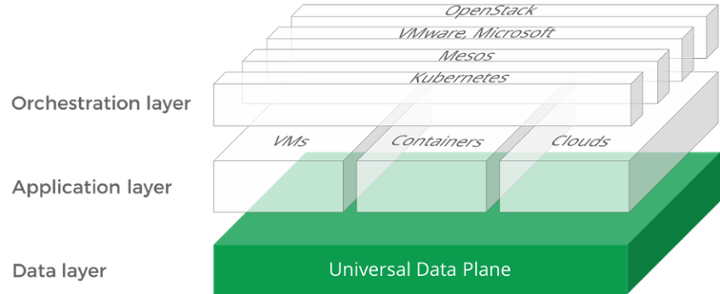Hedvig Vision for Future of Storage: Universal Data Plane
Programmable data management platform advancing multi-cloud strategies for businesses undergoing digital transformation
This is a Press Release edited by StorageNewsletter.com on September 28, 2016 at 2:58 pmIDC predicts organizations will spend $2.1 trillion in 2019 on digital transformation technologies.

As organizations get serious about building digital businesses, flexibility and responsiveness become their precious capabilities. To help companies realize the potential of their digital business, Hedvig, Inc. unveiled its vision for a Universal Data Plane, a programmable data management platform that overcomes the rigidity of traditional data infrastructure and removes bottlenecks to widespread digital IT transformation.
Topping the CIO priority list are investments in IT architectures to help with the rapid prototyping, deployment and scaling of digital services. Most organizations are turning to new application, container, and cloud technologies to support these efforts. However, data infrastructure simply has not kept pace.
“The journey to total digital transformation makes the public cloud attractive and, to some extent, inevitable. I believe on-premise data centers will eventually be eliminated,” said Avinash Lakshman, founder and CEO, Hedvig. “But today, many organizations still rely on their own data center or onsite IT and there isn’t a simple way for them to embrace the public cloud as an extension of their data centers. We believe traditional storage is the impediment.“

Case for Universal Data Plane
Many organizations deploy digital services in the public cloud. It’s the preferred starting point for many developers. However, once they reach even a modicum of scale, it can be quite costly to have that digital service run in the cloud permanently. Thus, integrating digital services across private and public clouds becomes an imperative. As organizations adopt a hybrid strategy they experience limited success because data portability – the ability to move data seamlessly among different workloads, clouds and tiers – remains elusive.
An Universal Data Plane overcomes the rigidity, economics and lack of data portability endemic to traditional storage. It provides a single, programmable data management layer that spans workloads, clouds and storage tiers. It replaces the need for separate, inflexible and costly storage gear because, as true software-defined infrastructure, a Universal Data Plane can be run on commodity servers in private clouds and as instances in public clouds. It’s a virtualized abstraction layer that enables any workload to store and protect its data across any location. It also dramatically simplifies operations by plugging into modern orchestration and automation frameworks.
Organizations can deploy services and applications that are stateless with a Universal Data Plane, providing data locality and availability guarantees. With a Universal Data Plane, organizations can support digital strategies including cloud arbitrage, reverse auctioning of cloud services and follow-the-sun application migration — all while avoiding costly bandwidth and egress cloud fees.
Universal Data Plane Logical Extension of Software-Defined Storage
To deploy the Universal Data Plane, organizations need to embrace a software-defined storage solution with four capabilities:
-
Scale-out, software architecture. Scale-up architectures simply don’t provide the flexibility that digital services require. Instead, a scale-out architecture, coupled with a software-defined approach, provides the elasticity to grow data services in lockstep with changing business requirements.
-
Native, multi-site replication. Modern systems can’t have single points of failure, nor can they support complex, bolted-on replication to improve availability. A critical element of the Universal Data Plane is the ability to natively replicate data among sites to ensure locality and availability.
-
Automation and orchestration support. Organizations can no longer suffer the human latency of manual provisioning. New orchestration tools have emerged that create composable infrastructure and services, and storage must provide a suite of APIs to integrate natively into these frameworks.
-
Application-specific data services. Not all digital services are created the same. Each service and application has its own unique data requirements. Modern storage provides the flexibility to give each application its own, unique policy, which can be augmented automatically as business needs change.
“We’ve found that traditional storage platforms, as well as some hyperconverged systems, are not designed to fully support public and hybrid cloud architectures in accordance with our needs,” said Magnus Blom, business area manager, outsourcing and managed services, DGC. “Hedvig helps us leverage software-defined storage as a critical component in our cloud infrastructure. With Hedvig, we have the flexibility to enable our customers to roll out digital services with our help and we can store, manage and protect their rapidly growing volume of data.“
The company’s Distributed Storage Platform is a software-defined storage solution built with the requisite scale-out, replication, automation and application-specific capabilities to function as a Universal Data Plane. It was designed as a distributed storage platform that can run on any commodity server or in any public cloud.












 Subscribe to our free daily newsletter
Subscribe to our free daily newsletter
